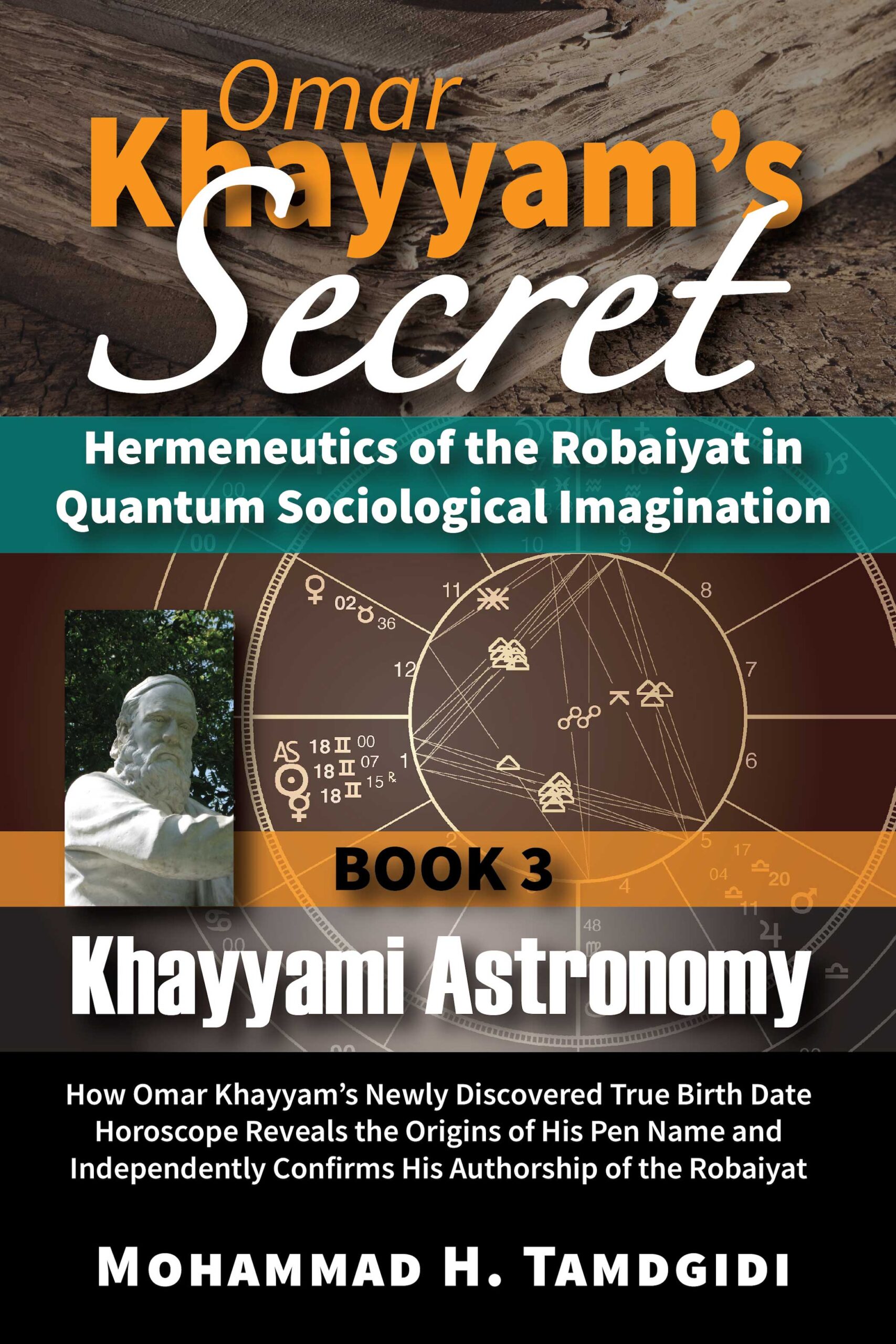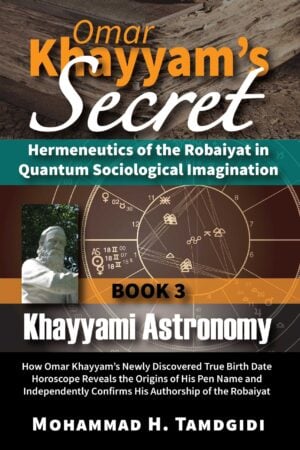Book Section: CHAPTER IV — Hermeneutically Interpreting Omar Khayyam’s Horoscope as a Whole: Discovering the Origins of His Pen Name — by Mohammad H. Tamdgidi
$20.00
This essay, titled “Hermeneutically Interpreting Omar Khayyam’s Horoscope: Discovering the Origins of His Pen Name,” is the fourth chapter of the book Khayyami Astronomy: How the Newly Discovered True Birth Horoscope of Omar Khayyam Reveals the Origins of His Pen Name and Independently Confirms His Authorship of the Robaiyat, which is the third volume of the twelve-book series Omar Khayyam’s Secret: Hermeneutics of the Robaiyat in Quantum Sociological Imagination, authored by Mohammad H. Tamdgidi.
Description
Abstract
This essay, titled “Hermeneutically Interpreting Omar Khayyam’s Horoscope: Discovering the Origins of His Pen Name,” is the fourth chapter of the book Khayyami Astronomy: How the Newly Discovered True Birth Horoscope of Omar Khayyam Reveals the Origins of His Pen Name and Independently Confirms His Authorship of the Robaiyat, which is the third volume of the twelve-book series Omar Khayyam’s Secret: Hermeneutics of the Robaiyat in Quantum Sociological Imagination, authored by Mohammad H. Tamdgidi.
In this chapter the author offers a hermeneutic interpretation of Omar Khayyam’s horoscope as a whole based on both its originally stated and its silent features as presented in Table III.1 in the previous chapter. Table III.1 presented the basic features of Omar Khayyam’s horoscope based on the astrological house and other definitions as traditionally held in Khayyam’s own time.
Tamdgidi’s purpose in this chapter is not to offer a conventional astrological analysis of a horoscope, as if we could learn something about Khayyam by “reading the stars” so to speak. Rather, his purpose is primarily hermeneutic in nature, that is, he wishes to understand how Khayyam, who was not only a master astronomer but also an expert in astrological knowledge—whether or not he actually believed in them, partly or not, differently or not—would have himself interpreted the intricacies of his own birth chart based on more or less standard traditional astrological definitions prevalent in his own time.
The idea is that to the extent we can hermeneutically decipher what could have been on his mind—in acceptance, doubt, or rejection—about what he was reading in his horoscope, we may also learn something more about him, both in terms of what he thought and felt and in terms of how he may have decided to write about himself and the world.
Tamdgidi finds, based on the study reported in the chapter, that we can definitively offer and consider the alternative, indeed textually reliable, new story that “Khayyam” was not an inherited, but an adopted, pen name—that the pen name has its origins in his horoscope, his natal chart, being comprised of an incredible array of Triplicities (or Grand Trines) as grand tents, being continually “stitched” by a Sun-Mercury-Ascendant conjuncting vertex. “The Khayyam who stitched tents of wisdom,” after all, had a definitive astronomical origin in his horoscope.
In the author’s view, our prior discovery of Khayyam’s true birth date, and consequently his true natal chart from a hermeneutic point of view, provide us now with defensible, textually reliable, grounds for a completely new story about where Khayyam’s name came from, to consider the possibility of a new and different story about the origin of his name that in fact now has much more solid basis in facts than its being conjectured to be simply a family name.
As Tamdgidi had stated previously, despite the fragmented and automated nature of standardized astrological interpretive reports and their inherent mechanical nature, their lack of awareness of the identity of the native being interpreted may be regarded as contributive to offering an “objective” interpretation of the native’s chart based on generally established astrological systems of interpretation, giving us a hint at what even Khayyam may have thought of his chart, given that he would have had to draw on a same shared tradition of astrological narrative and vocabulary to interpret it, believing in them or not.
His study leads the author to also conclude that the planet Venus plays a key and central role in Khayyam’s chart. Its mission is to consciously and intentionally stitch the Sextiles of his creative emotions to the powerful story of his chart’s multifaceted Air Grand Trines intelligence. This is done by willfully turning the Oppositional aspectations of his fate as found in the aspectations of the South Node with the Moon and the Midheaven into a redeemed Trine willed upon the South Node through the agency of the Trine emanating from his Venus’s playful creativity in search of happiness.
In other words, Venus’s secretive work in Khayyam’s chart has a lifelong creative function to perform, tasked with the salvation of Khayyam’s soul in both its this-worldly and next-worldly journeys, needing to stitch them together to survive forever in the hope of an immortal union with his Creator. Doing secretive, personal, private, creative work stitching mind and feelings and sensations is something a Khayyam expertly trained in astronomy and astrological judgments would read as being a central necessity to challenge and balance the enormous influence of the dazzling number of Air-Triplicities dominating his chart in a public way, continually being stitched in their shared vertex of a Sun-Mercury Samimi (Cazimi) on the cusp of the Ascendant at sunrise, on the borderlands of night and day.
Venus’s creative work in Khayyam’s chart serves the weaving, or the stitching, involving a conscious and intentional labor of love, seeking to fuse his mind, feelings, and sensations in the hope of a more lasting existence. Dealing with the private-public dualism so as to overcome it through a superposed attention to continually stitch the mind, feelings, and sensations expressing his intellect, soul, and body, requires making and playing a music of his own sphere in search of his beloved God amid a shared Cazimi-vertex fastened set of dazzling grand-tented Air Triplicities.
Khayyam may have grown up with a deeply personal reason to learn the sciences, especially mathematics and astronomy, to investigate for himself, and to prove to others, that he was indeed a Sun-Mercury Samimi (Cazimi), while also knowing that engagement in creative writing of poetry may have been a project he was duty-bound to undertake to balance and counter the determinism of the spheres with the resisting and balancing act of his own intellectual and creative, including also poetic, work.
His publicly stated horoscope, then, was not just an origin story, but also a gist of what he triumphantly discovered, a summary of a wider story parts of which he chose to keep secret.
Recommended Citation
Tamdgidi, Mohammad H. 2021. “CHAPTER IV — Hermeneutically Interpreting Omar Khayyam’s Horoscope as a Whole: Discovering the Origins of His Pen Name.” Pp. 131-176 in Omar Khayyam’s Secret: Hermeneutics of the Robaiyat in Quantum Sociological Imagination: Book 3: Khayyami Astronomy: How Omar Khayyam’s Newly Discovered True Birth Date Horoscope Reveals the Origins of His Pen Name and Independently Confirms His Authorship of the Robaiyat. (Human Architecture: Journal of the Sociology of Self-Knowledge: Vol. XVI, 2021. Tayyebeh Series in East-West Research and Translation.) Belmont, MA: Okcir Press.
Where to Purchase Complete Book: The various editions of the volume of which this Book Section is a part can be ordered from the Okcir Store and all major online bookstores worldwide (such as Amazon, Barnes&Noble, Google Play, and others).
Read the Above Publication Online
To read the above publication online, you need to be logged in as an OKCIR Library member with a valid access. In that case just click on the large PDF icon below to access the publication. Make sure you refresh your browser page after logging in.






